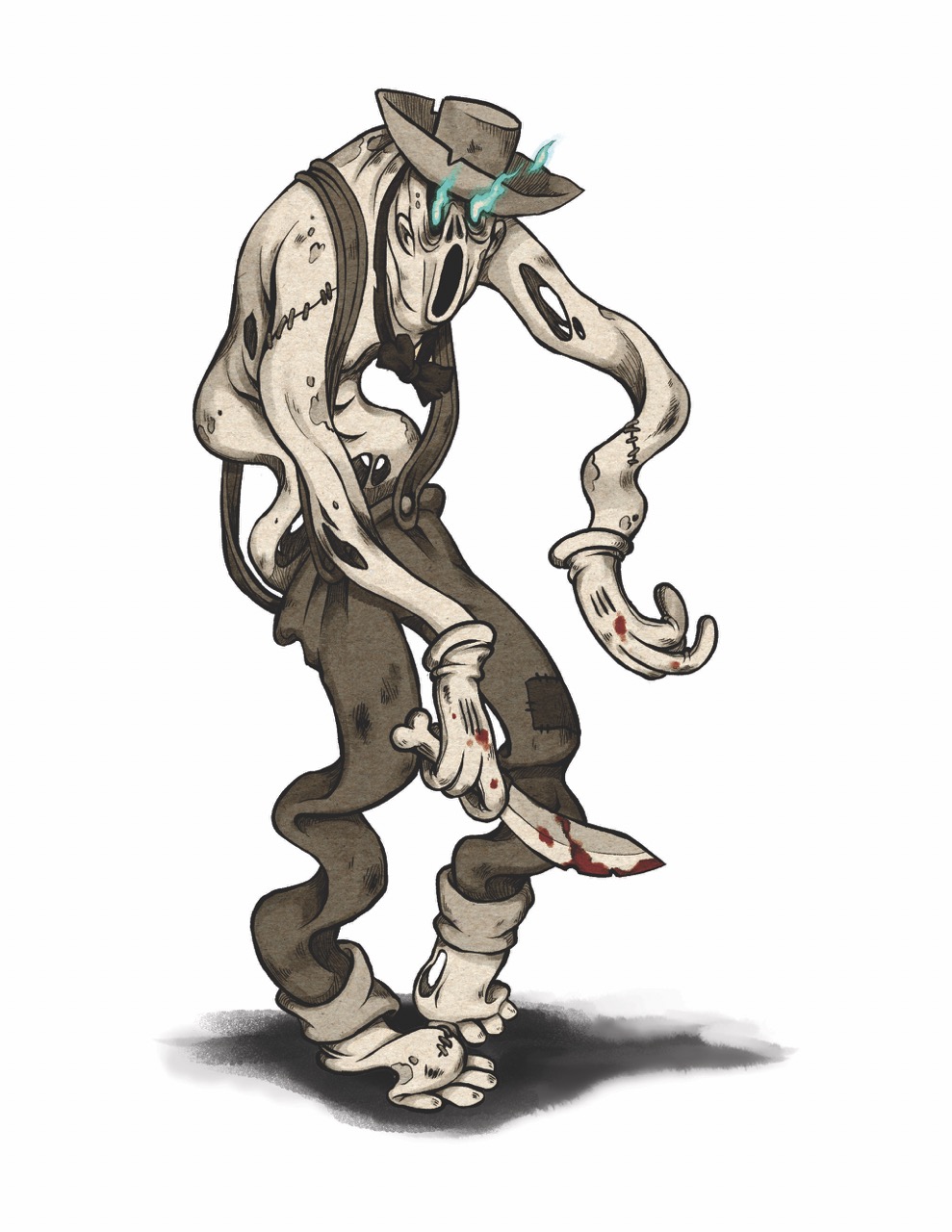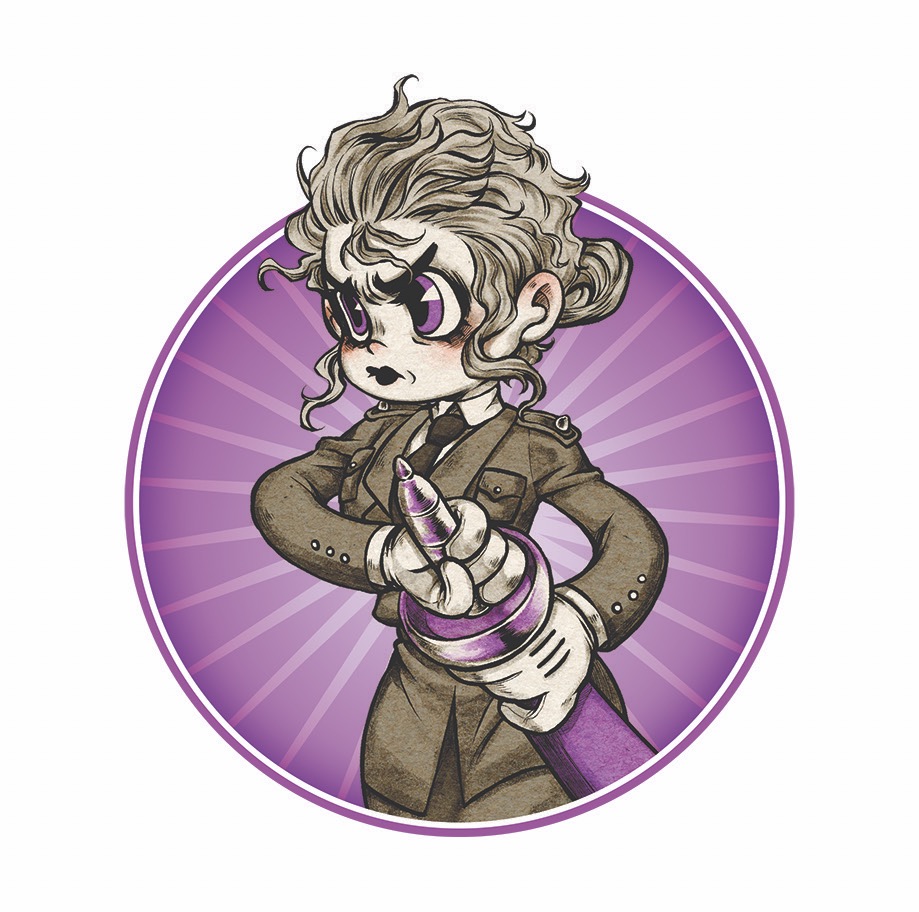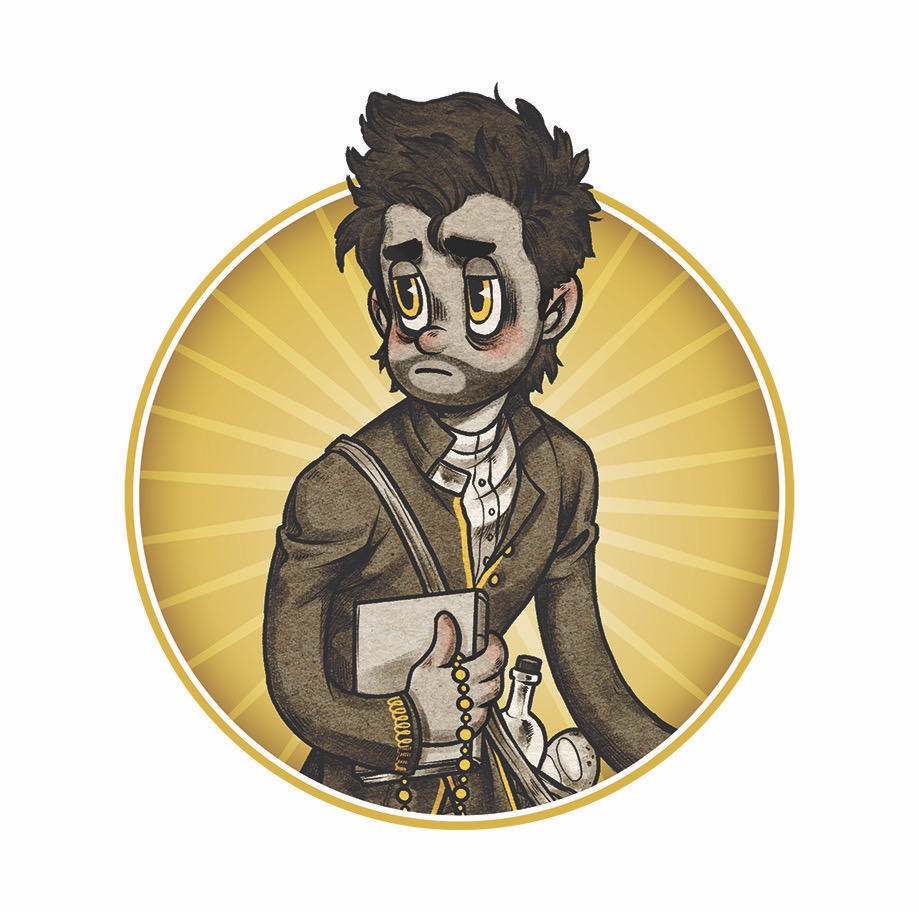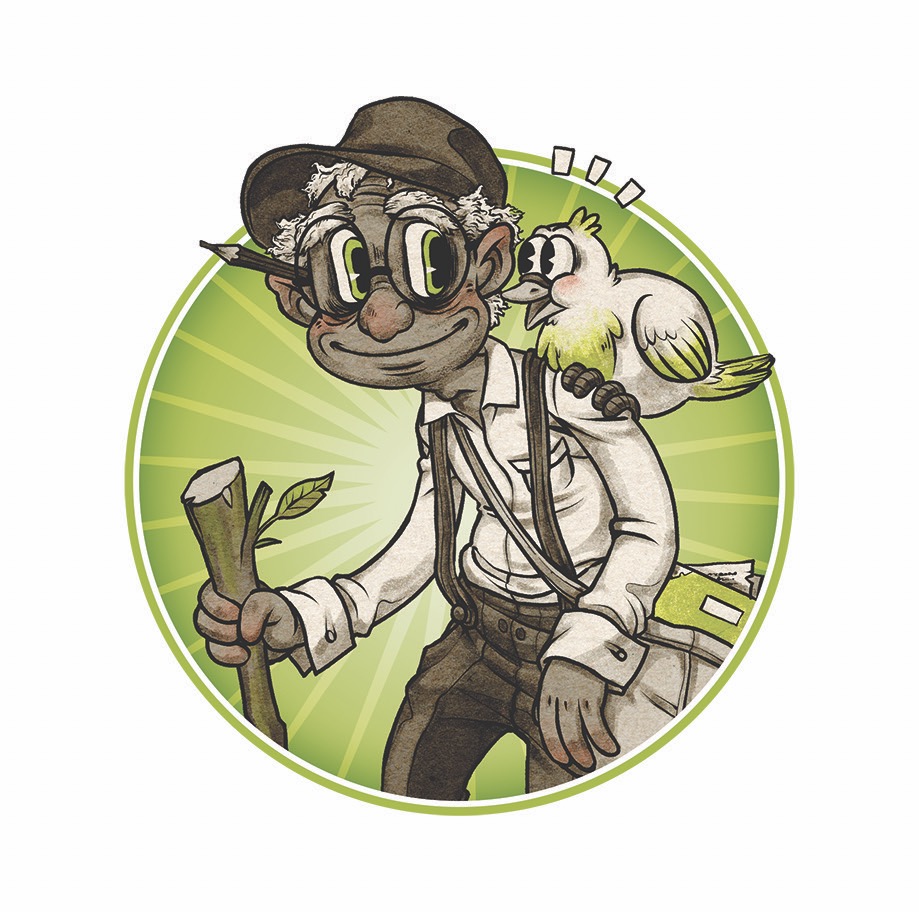17 January 2022
|
Skip to the spooky side of the tracks with Wyrd Games’ boss battler, Vagarantsong
This article originally appeared in issue 58 of Tabletop Gaming, and was written by Charlie Pettit. Pick up the latest issue of the UK's fastest-growing gaming magazine in print or digital here.
“We call it rubber hose,” says Kyle Rowan, describing the art style of their new boss battler, Vagarantsong. Rowan is the design lead at Wyrd Games, a company best known for its card driven skirmish game Malifaux, now in its third edition. Wyrd started out in the industry as a miniatures company, so this more recent interest in board games shows a bold and interesting direction for the company. While Rowan is the design lead on all the games at the studio, Vagrantsong is his baby.
“It’s loosely 1920s,” continues Rowan, “we don’t actually say outright, as we like to have fun with time in the game. We’ve looped in certain reference that might not be accurate to the 1920s – but for the most part you’ll get that sort of ‘American Dustbowl’ vibe from the game.”
The setting drives all the flavour of the game. Players will be taking the role of vagrants in the game, the classic ‘hobo’ of the period. They’ll be attempting to beat, or ‘solve’ each of the bosses of this game across over 20 scenarios using what they have to hand – all inside a train carriage they wish they’d not hopped on. Now, the ghost train they’ve trapped themselves on is hurtling down the tracks, and there’s something spooky going on.
HAINT THAT THE TRUTH
That spooky thing is the Haints you’ll be fighting or fixing in each scenario.
“Haint is just a Southern terms for ghosts,” says Rowan, “it’s looped into a lot of folklore. There’s even a colour called ‘haint blue’ that has significance in the game, but also in superstition in the South. Some people paint their balconies haint blue to ward off ghosts from entering their homes.”
“We wanted to create as many strange reference as possible. You’ll also see there’s a lot of hobo terminology in the game, for example when you die in the game, you don’t remove your character, you flip your character card over to the westbound side. Which is what hobos would say about their friends who would pass – ‘they’re travelling westbound’,” continues Rowan, a reference to the fact that much of the vagrant travel of the time would be west to east.
The haints themselves are the stars of the show, each one is a boss representing a traveller who has lost their humanity. Because the game is a little bit of a boss rush game, we obviously begin to invoke Dark Souls – but only if you preferred to play with friends. Rowan also cites Shadows of the Colossus, as you’re not just beating the enemies to death, but solving them as puzzle.
“We wanted to really dig into the puzzle design of these bosses,” says Rowan, “so each boss essentially has its own set of rituals, which aren’t necessary but they do make things more accomplishable.”
The actual ‘combat’ of the game comes from the humanity system, “Vagrants have humanity, and haints don’t – and you’re trying to give them back their lost humanity.”
“And one thing this allowed us to do was to create skills and actions that could target both the haint and the vagrant that lets them gain humanity,” continues Rowan, meaning that when you target a vagrant, that player character is healed by gaining humanity, and when you’re targeting a haint, you’re ‘doing damage’.
“This let us create a ‘heal but hurt’ kind of vibe with our actions,” says Rowan.
It’s a bit like a system where you’re healing a zombie back to life, or returning sanity to the insane, or more accurately in this case – trying to remind a ghost of their past.
SING YOUR SONG ![]()
The game works on a system of action points, represented by the three coins that they can spend on their turn. There’s a set of five general actions players can take, move, rummage, investigate, patch up, and bust. On top of this players have access to their skill cards, which are slotted on to the side of their player board, and their junk cards – which are sometimes powerful items that have been rummaged up during their adventures, usually offering passive powers. Some of these skills will be unique to each vagrant type, while others will be universal, allowing players to swap out their equipment during the loadout phase prior to the next scenario.
“But the skills are more than just skills, they’re also a way to quantify health in the game,” explains Rowan, “a vagrant has 10 humanity on average, but that changes from vagrant to vagrant. Once you get down to zero, you flip over a skill card to the wounded side – so if you’ve got four skills, you’ve got 40 humanity. Flip over all those skills, and you’ll go westbound.”
A similar mechanic happens with haints. They have a ‘break’ system where you might need to restore 15 humanity to them, but you’ll need to do that three times. And here, when the breaks take place, you might get new behaviours in the fight – in classic ‘second phase’ style.
Character progression comes through those skill cards. Each vagrant starts off with two skill cards – like the runaway with their pup card, which allows them to bring their puppy standee along for the adventure.
“But as far as how skills are acquired – some are going to be found directly within the scenario,” says Rowan, “you can stumble across something in the corner of the train, but the most common way of finding skills is after the scenario, in the ‘camp’ phase.”
“You’re unwinding and healing up from the scenario. Each boss has their own camp phase, with unique skills tied to it. The aim for us was less about creating an XP system, and more about creating a system where the boss translates into skills. Things that the haint did, or the story that way involved and allow that to change the vagrant more than ‘grow’ them,” continues Rowan, “a vagrant is generally going to expand outward rather than upward in regards to power.”
And players will need these powers to overcome many of these haints, as the ‘haunt’ mechanic that the enemies use can vary between characters. The effect of being haunted is simple, when a haint walks into the same space as a vagrant – they’re haunted, usually doing some damage, and maybe something else too.

ROLL THE BONES
Coming from a company that makes wargames and miniatures at its heart, Vagrantsong uses dice for its skill checks. You’ll be rolling D6s to match various value thresholds for each skill.
“Sometimes it will depend on how many coins you put into it,” says Rowan, “and in other instances it’s a static number but the coins are going to provide a different sort of modifier such as each success might grant more coins, humanity – that sort of thing.”
Rowan shows us an early example from the game, a skill called the two-step shuffle.
“So one thing that we really wanted to make sure was important in the game is creating an overall theme that you aren’t necessarily attacking these haints,” says Rowan, “you are reminding them of their lost humanity. So in this instance, you’re literally dancing to teach them that, you know, sometimes it’s just worth having fun.”
The skill has four stats to consider, the targeting, which in this case is just haints, the range, the bones equal coin symbol – meaning you roll bones equal to the number of coins you place on it, and the success value is three or above.
“So in this instance, it says the target gains two humanity, and for each success you move one away from the target,” explains Rowan, “so the way this is going to work is that as long as you succeed, at all, the target is going to gain humanity. But for each success you’ll get a little move bonus, and you get to increase your chances of success by however many coins you’ve placed to create the pool of bones.”
“That’s a really straightforward early example, from early on in the game. But they get a lot stranger as the game goes on.”
All of the skills in the game have these excellent thematic ties. The cartoony idea of dancing away in combat – which is also a very effective strategy for placing your characters in advantageous positions has an arena combat feel about it, while staying true to the heart of the game.
While there’s an alternating turn system, player can commit all of their coins on a single go – meaning you can do more complex things in your turn than simple single actions.
The haints on the other hand share the bindle bag system (a bindle being the handkerchief tied to a stick you remember from old cartoons), which offers players a kind of bag building mechanic. Here vagrants can ‘rummage’ and pull one of five token types from the bag, all of which provide various power and abilities for them to perform.
But the haint is also going to use tokens drawn from this bag to dictate the actions they take on a turn, “so what ends up happing is a kind of ‘deck thinning’ effect with the rummaging,” explains Rowan, “when using a rummage token it goes on a specific track called the cycle track. So holding on to certain powerful rummage tokens for a while also remove it from the bindle, lessening the odds of the haint drawing it to perform that big ugly attack.”
This bit of control that players have reminds us of abstract war game classic, War Chest and “on average, the haint is going to have two different moods in their scenario, and they’ll change based on specific criteria – like after a set number of rounds, or if you’ve broken them once,” adds Rowan. Their attacks are dictated by what gets pulled out of the bag directly, then added to the cycle track – after a slot is filled to its maximum, the tokens go back in the bag, meaning those nasty attacks just got refreshed.
“In addition to mitigating what haint actions can take place based on the tokens you’re holding on to, you’re also aware of the explosive actions that can take place,” says Rowan.
Talking in detail of the haints, Rowan is obviously trying to avoid spoiling the game ahead of launch, but he’s happy to share a few. 
“We generally tried to pull from classic American ghost stories. The first scenario has the turned faces – a group of three haints you encounter after hopping on the train for the first time, before you know what’s really going on,” divulges Rowan, “and you see these three people ahead of you who refuse to acknowledge you – and it turns out their head are forever turned.”
Outside of the tutorial scenario, you first meet the flayed man, “the flayed man is literally a seven foot tall skin man. He’s the character who actually welcomes you on to the train – generally speaking train hopping wasn’t exactly something you were encouraged to do freely, so you had to hide. So you’re caught off guard by his welcoming hand.”
“The flayed man is a long range, loopy, silly character – who is also terrifying because he’s just skin. He’s one of the recurring characters in the game.”
Other characters include Maco Joe – based on the story of ‘ghost lights’ occasionally seen in North Carolina until as late as 1977. The lights were said to look like a railroad lanterns.
“The story is that Maco Joe was a break man who lost his head, and those lights are him trying to find it,” explains Rowan, “we’ve translated that into Vagrantsong as a headless break man who is bumping into terrain. He’s not really able to recognise you, but when he finds his head he changes moods and things get a lot scarier.”
HIGH SPEED RAIL
The game is designed to be set up and torn down quickly, with accessibility at the heart of the experience. It’s challenging, with “the good type of stress” – but with a focus on progress.
“There are mechanics in the game that are going to help you bring yourself back from defeat,” explains Rowan, “and when you lose a scenario, you don’t have to replay it. You can still move forward into the next scenario – but certain mechanical and story elements will change on that loss.”
“It’s not a legacy game,” he clarifies, “but there is a feeling of stacking mechanics that happens throughout the game. A lot of the joy of the game comes from unravelling the mysteries and secrets as you go.”
“I love dungeon crawlers, but I don’t know if I could sit down and play something with a hundred scenarios these days,” says Rowan, echoing a common thread in the hobby. We’d all love to work our way through epic stories, but with busy lives and not always having spare space available for larger games, something that can be set up and played in 30-40 minutes is a big selling point.
Wyrd are launching the game at Gen Con 2021 in September, with a worldwide release at the same time – although a vaguer ‘fall’ release window seems more appropriate.
“It’s probably our biggest Gen Con ever,” says Rowan, “we’ve got a new Malifaux expansion where we have given each Master a makeover, and we’re essentially giving each one a new play style.” The company also has a new The Other Side starter box ready for the show, and Bayou Bash – a gremlin-on-rabbit-back racing game.
“A few years ago we dipped our toes into board games with Darkness Comes Rattling. But Vagrantsong shows we’re taking board games very seriously.”
OUR UNLIKELY HOBO HEROES
Kyle Rowan takes us through the motley crew of vagrant characters we can play as in Vagrantsong
 The Cursebearer
The Cursebearer
“She’s one of the more aggressive characters in the game. Her backstory is that she’s been running from a demon for a very long time, and she’s jumped out of the frying pan into the fryer by hopping on this train. She can hurt haints when they haunt her – so when a haint attacks the Cursebearer, she hurts them right back.”
 The Songsmith
The Songsmith
“The songsmith is a kind of all around generalist. He benefits from spreading his coins across as many skills as possible. As long as there’s one coin on a single skill, the success value requirement drops a little bit. He’s hopping on the train to try and make it big.”
The Runaway 
“She’s run away from home, and she’s taken her trusty pup with her. And that’s essentially her unique mechanic – the player controlling the Runaway is going to be controlling two characters. She can be doing one thing on one side of the train and the pup can be doing something totally different.”
 The Empress
The Empress
“She’s loosely inspired by the Emperor of America, a famous hobo in San Francisco who had the impression they were running things. She’s a character who’s trying to amass her own army. She’s both an aggressor and a utility character. She takes advantage of ‘Booming Boxcars’ in the game, where if you roll a six, you keep rolling.”
The Revivalist 
“He’s the healer of the game. His backstory is that he’s failed helping friends and family find solace through connecting with the realm of the dead. He’s a twist on a classic healer character as he’ll be doing damage as well. He’s also the only character who can patch up other characters in the game”
 The Wayfarer
The Wayfarer
“He is the tried and true hobo. The more traditional one, living life freely on the road. His benefit is that he gets two junk slots. So you get to modify the passive effects however you want to. It also gives him a more tanky vibe as he has another card to flip over, so he’s going to have more humanity overall.”










Comments
Login or register to add a comment
No comments